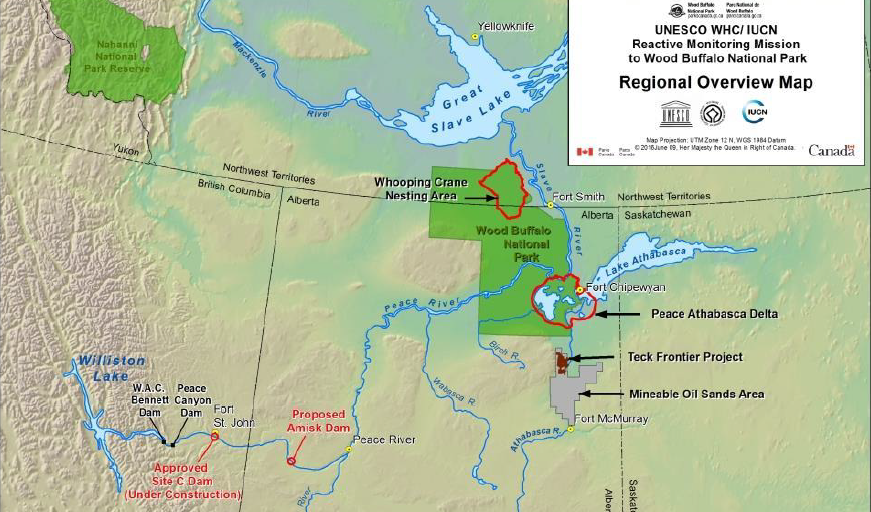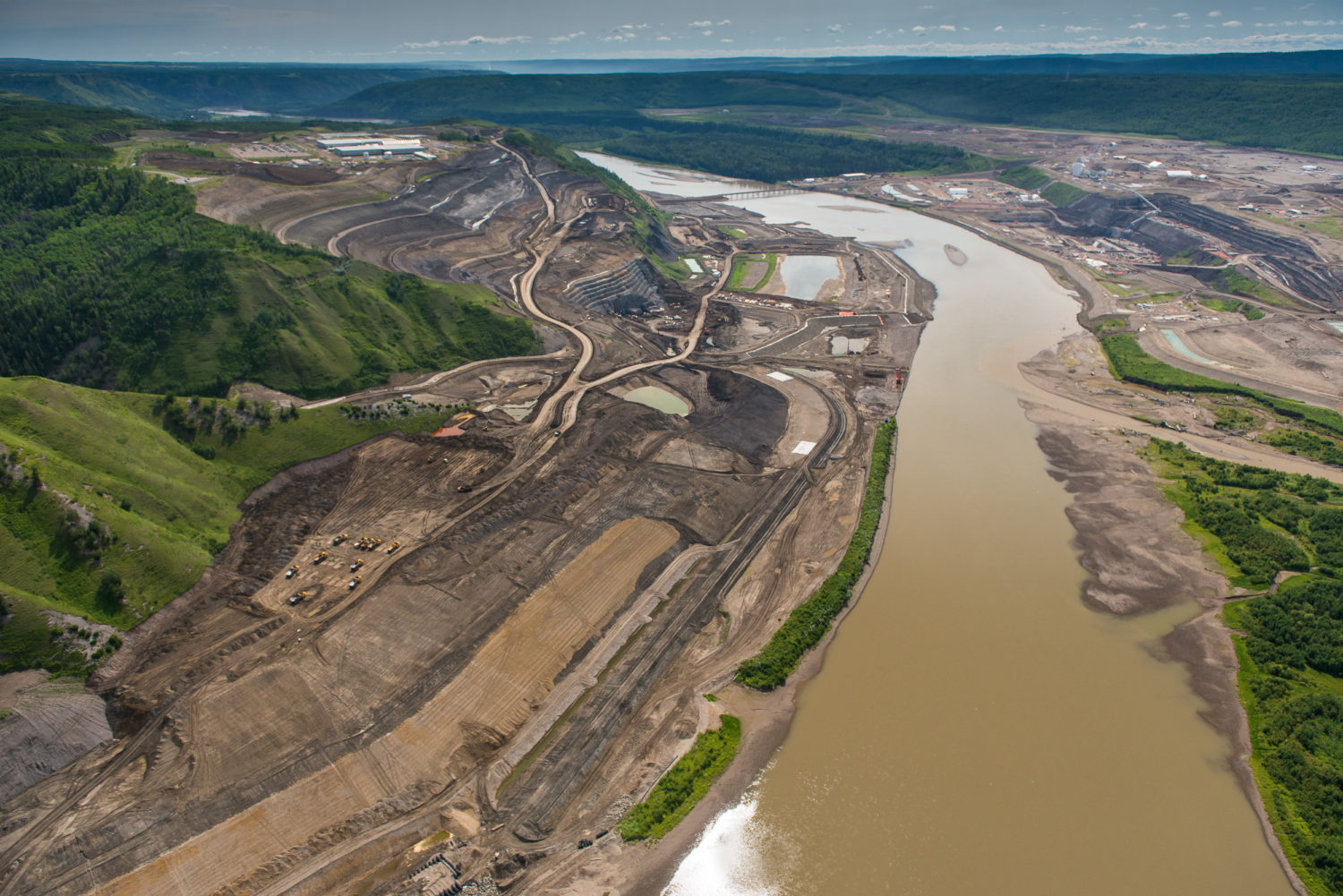
Court halts tailings increase as First Nation challenges B.C.’s decision to greenlight it
Court sides with Xatśūll First Nation, temporarily halting Mount Polley mine waste expansion
The federal government is promising to create artificial ice jams, strategically release water from BC Hydro dams and assess cumulative impacts on northern Alberta’s Peace-Athabasca delta in an attempt to retain the World Heritage status of Canada’s largest national park.
However, Ottawa’s long-awaited action plan for Wood Buffalo National Park rejects a World Heritage Committee recommendation calling on Canada to conduct an environmental and social impact assessment of the controversial Site C dam. The action plan says the federal government’s hands are tied because an assessment of the project was completed by a federal-provincial review panel
before the dam was approved in 2014.
“There is no legal mechanism in federal legislation to suspend or negate the authorization or undertake a new environmental assessment for a project that has been approved,” says the 96-page report compiled by Parks Canada, in consultation with 11 Indigenous communities and the B.C., Northwest Territories and Alberta governments.
The Canadian Environmental Assessment Agency is “actively verifying that BC Hydro is complying with the conditions,” the report adds.
In 2014 the Mikisew Cree First Nation, alarmed by the deteriorating park environment, asked UNESCO’s World Heritage Committee to add Wood Buffalo to the list of World Heritage in Danger.
Following a visit to the park by committee members and representatives of the International Union for Conservation of Nature, UNESCO warned that, because of poor management, the park was in danger of losing its World Heritage status and made 17 recommendations, including an assessment of the effects of Site C on the park.
Canada was asked to produce a plan addressing the recommendations and detailing how to restore ailing ecosystems in the 4.5-million hectare park.

Map of threats to Wood Buffalo National Park from UNESCO report.
Water levels in the Peace-Athabasca delta dropped after the 1968 construction of the Bennett dam on the Peace River, followed by the 1980 Peace Canyon dam. Indigenous communities, many of whom rely on the delta for fishing and hunting, are among those who fear the Site C dam — the third dam on the Peace River — will mean further decreases in water levels in the delta.
BC Hydro community relations manager David Conway disagrees that the delta’s water woes stem from the Bennett Dam or that Site C will be a threat.
“Researchers from a number of universities across Canada who conducted research at Wood Buffalo National Park have found the changes observed with the Peace Athabasca Delta are consistent with that of a naturally evolving delta with climate change,” Conway wrote in an emailed response to questions from The Narwhal.
“During the environmental assessment of Site C, we commissioned studies from leading experts to evaluate the potential downstream effects of the project and, in all cases, it was concluded that the project would have no notable effect on the Peace-Athabasca Delta,” he wrote.
The view from the ground is different and Indigenous communities say there are areas of the delta where they can no longer take boats to reach traditional hunting grounds, while fewer ice jams are changing the landscape and causing lakes to dry up.
Climate change is acknowledged as part of the cause — with the action plan estimating that the average annual temperature in the park has increased by two degrees and the winter temperature by four degrees — but residents believe many of the delta’s problems are caused by Peace River dams, water withdrawals by the oil and gas industry and contamination from the oilsands.

Cracked earth details in Wood Buffalo National Park’s Salt Plains Outlook trail. Photo: Louis Bockner / Sierra Club BC
Site C looms large in those concerns, said Becky Kostka, Smith’s Landing First Nation lands and resources coordinator.
“This is not good enough. Canada really needs to step up,” said Kostka, who was hoping pressure from the UN Committee on the Elimination of Racial Discrimination would help push the federal government into taking another look at the ramifications of Site C.
Last month, the committee wrote to Canada’s ambassador to the UN expressing concerns that the dam would permanently affect the land rights of Indigenous peoples in B.C.
Galen Armstrong, a campaigner for Sierra Club B.C., said omission of a Site C assessment means the plan — although it includes some long-overdue measures for improving and monitoring the health of Wood Buffalo — fails to address underlying issues.
The fact that BC Hydro is considering releases of water from the Bennett dam is an admission of the impact the dam has had downstream and building another dam is contrary to protecting the delta, Armstrong said.
“When the committee meets again, I don’t expect it to be satisfied with this response. Canada is leaving Wood Buffalo National Park open to earning a World Heritage Site in Danger status and, to me, it shows it wasn’t taken as seriously as it should have been,” he said.
Gillian Chow-Fraser, boreal program manager for the Canadian Parks and Wilderness Society, pored over the draft action plan and the final document looking for differences and, although she applauds the weight given to Indigenous experiences in the final version, she is disappointed the two documents are so alike.
It is odd to say cumulative impacts will be considered and then ignore the Site C dam, which is one of the biggest potential impacts, Chow-Fraser said.
“They don’t address the impacts of Site C at all. They just throw their hands up in the air and say it has been approved.”

Site C dam construction on the Peace River, July 2018. Photo: Garth Lenz.
The action plan recommends coming up with a protocol to look at how water releases from the Bennett dam could enhance ice jam flooding and what risks “strategic flow releases” would have on communities and infrastructure downstream from the dam
Proposals include “enhancing” spring flooding and creating ice-dams from spray ice, but Chow-Fraser hopes any artificial manipulation of hydrology in the delta will be approached cautiously.
“We don’t know the potential knock-off effects,” she said.
“It seems like a really big action and I don’t know if it’s the most effective way of restoring the ecosystem — especially when they are ignoring Site C,” she said.
Melody Lepine, director of government and industry relations for the Mikisew Cree, believes timed releases from the dam could be positive and she is encouraged that BC Hydro is willing to help restore some ecological functions of the delta.
“It’s a start. BC Hydro needs to be part of the solution. They control the faucet,” said Lepine, who is also encouraged that the final plan toughens up the requirement for buffer zones around the park and that industry withdrawals of water from the Athabasca River will come under scrutiny.

Peace Valley farmers Ken and Arlene Boon look out onto the Site C dam’s construction zone from a neighbour’s property downstream on the Peace River. Photo: Sarah Cox
But a funding question mark hangs over the action plan with fears that the $27.5 million earmarked over five years by the federal government for development and implementation of the action plan isn’t enough.
Lepine, looking at potential costs, said Canada should have started budgeting for Wood Buffalo several years ago and determining a cost for the actions should have been part of the action plan development.
“Now it’s an afterthought,” she said, pointing out that Australia has spent half a billion dollars to restore the Great Barrier Reef. “When I look at other sites around the world and what other countries have spent, I give my head a shake.”
Lepine worries that the plan has big ambitions, but is too vague, leaving questions such as how, when and who is going to pay for it.
“There are so many issues and challenges, so it’s hard to measure what success will look like. That’s how Canada gets caught up in these broken promises,” she said.
Kostka echoes concerns that the plan lacks specific measurements — with Alberta’s role largely limited to dealing with problems through existing legislation — and that the funding is insufficient.
It is unclear how the existing funding will be used and whether Indigenous groups will be offered funding to help with implementation of the plan, she said.
“We need a long-term commitment… I don’t know how many ways that $27.5 million can be split over five years,” Kostka said.
Lepine’s hopes are now pinned on the World Heritage Committee and the International Union for the Conservation of Nature when the plan is presented in Azerbaijan in early July.
“I think the committee has a lot of influence and can push Canada to do something. Canada is not going to do anything unless they are forced to,” Lepine said.
Get the inside scoop on The Narwhal’s environment and climate reporting by signing up for our free newsletter. On a warm September evening nearly 15...
Continue reading
Court sides with Xatśūll First Nation, temporarily halting Mount Polley mine waste expansion

Break out the champagne: Emma’s storied life and leadership in journalism has earned her the...

How can we limit damage from disasters like the 2024 Toronto floods? In this explainer...
